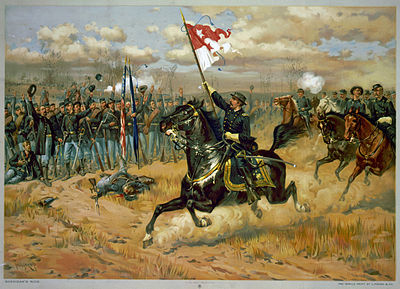After the defeat
of the June 3 attack on the Confederate lines at Cold Harbor, Grant
decided to change his plans. Through the Overland Campaign he had
tried to crush Robert E. Lee, and after each failure he would move
around the Confederate right, edging closer to Richmond. But unlike
previous commanders of the Army of the Potomac, his end goal was not
the capture of Richmond, but the destruction of Lee's army. He
decided that he next step would be another move around Lee's right,
but this one more drastic. He would cross the James River and aim to
capture Petersburg, an important railroad junction south of Richmond.
To cover this
movement, Grant sent his cavalry under Major General Philip Sheridan
on a raid against the Virginia Central Railroad. Just as he was about
to set out, news came of David Hunter's victory in the Shenandoah at
the Battle of Piedmont. Grant ordered that Hunter join Sheridan near
Charlottesville so that the united forces could pose a major threat
to Lee's left.
Sheridan's men set
out early on the morning of June 7. The weather was hot and the
movement was slow. Many horses fell by the wayside, still not
recovered from the hard riding the previous month that culminated in
the Battle of Yellow Tavern. The Confederate cavalry, now under Wade
Hampton, received of this movement the next day, and he assembled his
division at 2 am on the morning of June 9th to head after
Sheridan. Fitzhugh Lee's division would follow not far behind.
Although the Yankees had nearly a two day start, the Confederate
troopers were more familiar with the country and had the shorter
inside track.
 |
| Map of Day 1 |
Both Union and
Confederate forces camped near Trevilian Station on the Virginia
Central on the evening of June 10, and the next morning Hampton told
his brigade commanders that he planned to fight. He devised a plan to
surprise Sheridan's men. He placed one division on each side of the
crossroads, hoping the surprise the enemy and crush them in between
the two groups of Confederates. As the battle began, Fitzhugh Lee did
not arrive where Hampton wanted him, and in heavy fighting in the
thick brush he was forced back by Sheridan's larger numbers. The
situation worsened for the Confederates when Union commander George
Custer led his brigade right down the road to Trevilian Station, and
found Hampton's baggage and many of his men's horses left complete
unguarded. He joyfully secured these, but the situation turned sour.
Hampton redirected his men to met this surprise threat from Custer,
and the Union commander found his men attacked on three sides. As he
retreated with his spoils he found a Confederate battery directly in
his escape route. With his force surrounded, Custer believed he was
about to be overrun, so he pulled his flag down from its staff, and
hid it in his coat. Disaster was finally averted when Sheridan led
two brigades in a charge, driving Hampton's men to the west. Another
brigade hit Lee's flank and he fell back to the east. Custer had lost
hundreds of men, but he had been saved from complete disaster. When
Sheridan asked him if he had lost his colors he triumphantly pulled
them out of his coat and proclaimed, “Not by a d--- sight!”
 |
| Map of Day 2 |
That night Lee
moved his men to the south and joined Hampton. Sheridan received
several pieces of news that caused him to order a retreat. He head
that Confederate infantry were nearby and that David Hunter was not –
he had marched to Lynchburg instead. The next day, while some of his
men wrecked Trevilian Station, he sent Torbet's division west where
they encountered Hampton and Lee in an L-shapped position, well dug
in. The Federals attacked again and again, but they were unable to
break through this line. Instead they were met with a heavy counter
attack from Lee. That night Sheridan withdrew and began a leisurely
march back towards Cold Harbor.
 |
| Sheridan |
In this battle
Sheridan had lost just over 1,000 – 102 killed, 470 wounded and 435
missing and captured. The Confederates lost about 830. It was the
largest and bloodiest cavalry fight of the entire war. On the first
day of battle the Federals had clearly successfully, but they were
unable to continue this on the second day. The campaign was also not
an unmitigated success. It may have done something to distract Lee
from Grant's movement across the James and Sheridan did destroy a
section of the Virginia Central, but the Confederates were able to
get the railroad up and running again in short order, and since
Hunter did not join Sheridan there was no serious threat to Lee's
flank. All in all this battle did little for the Union cause.




0 comments:
Post a Comment